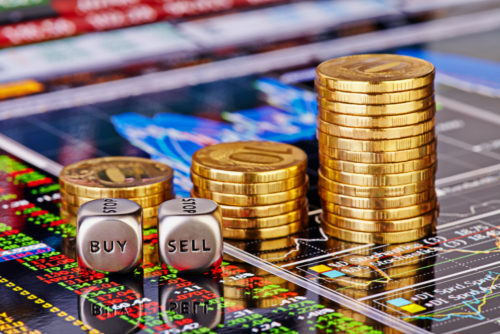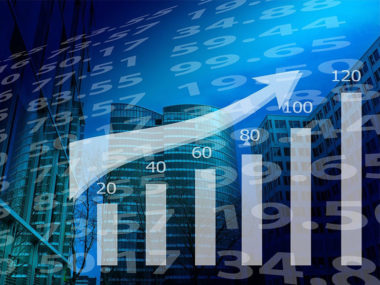Exchange-traded funds (ETFs) are funds that you can buy or sell through a broker or on an online trading platform. Unlike a regular stock, an ETF stock does not represent a share of one company. Instead, it represents ownership of a portfolio of related stocks or other assets.
There are many different categories of ETFs. For example, some exchange-traded funds contain all the stocks in a specific market index, like the S&P 500 or NASDAQ. Other ETFs have assets related to bonds, commodities, a currency pair, or an industry.
In simple terms, ETF investing allows you to invest in a group of securities without having to buy multiple stocks or risk your investment budget on a single asset.
Table of Contents
ETF vs Stock: What’s the Difference?
ETFs are designed to be traded, like stocks. Before ETFs, investors had to rely solely on mutual funds. Like ETFs, mutual funds consist of a collection of related securities. However, investors cannot trade mutual funds on an exchange. They can, however, purchase shares of an ETF through a brokerage or trading platform in the same manner that they would buy shares of a publicly-held company’s stock.
The primary difference between a stock and an exchange-traded fund is that a stock represents one company, while ETF investors are purchasing a collection of different assets. For example, the ETF with the ticker symbol SPY contains stocks from the S&P 500. When you buy a share of SPY, you are purchasing a portfolio that contains all those stocks.
There are some additional, subtle similarities and differences between stocks and ETFs. Like mutual funds (but unlike individual stocks), ETFs may charge a fee to owners. The fee covers the cost of maintaining the ETF. Also, stocks often pay dividends to shareholders. Some ETFs also pay dividends, but dividend payments are smaller and get rolled back into your ETF share, rather than going into your bank account.
How Do ETFs Work?
ETFs trade on exchanges just like stocks. You can purchase and sell them in the same places where you buy and sell single-company shares. Also, like stocks, ETFs have ticker symbols, so you can get data and see real-time prices.
ETFs trade like stocks on trading platforms and through traditional brokerages even if they contain assets that aren’t directly related to stocks. For example, you can trade a commodity ETF or bond ETF on a regular stock-trading platform. You do not need to open a special account with a commodity or forex broker.
The number and percentage of shares and assets that make up an ETF can change. The fund creator can make new shares, and sometimes adjusts the composition of the fund so that it accurately tracks the target market.
ETF Benefits and Drawbacks
After you understand what ETFs are, it’s worth evaluating their advantages and disadvantages.
Like any investment, exchange-traded funds come with risks and potential rewards. Investors need to compare risk versus reward when deciding whether or not to invest in ETFs and which funds to purchase. Some funds, such as leveraged ETFs, are very risky, while others focus on providing slow-but-consistent growth for long term investors.
ETF Advantages
ETFs come with specific advantages. These positive attributes can make them attractive to individual investors.
- Diversification. With ETFs, you do not have to put all your eggs in one proverbial basket. You can use a fund to track the performance of an entire sector, market, or country. A single company may underperform or over-perform compared to their industry or index, but if you have a fund made up of multiple stocks, the performance usually evens out.
- Access to inaccessible markets. With ETFs, you can gain access to foreign markets and to markets that have a high price of entry. For example, exchange-traded funds lower the cost of entry for commodities markets, foreign exchange markets, and bond markets. Individual investors often lack the capital to invest directly in such markets.
- Convenient trading process. You can trade ETFs on a regular stock trading platform. A stockbroker can also provide access. Furthermore, trading fees for exchange-traded funds are comparable to the fees that you pay to buy and sell individual stocks.
- Lower fees than mutual funds. Like mutual funds, ETFs have management fees. However, in most cases, ETF fees, known as expense ratios, are much lower than those attached to mutual funds. The reason for this is that mutual fund managers actively change their portfolios, while most ETFs passively track a target market.
- Tax advantages. ETF owners have less exposure to capital gains taxes. If a mutual fund manager sells an asset that is part of a mutual fund, the investors have to pay capital gains on the profits of that sale. They have to pay taxes on these gains even if the fund loses money overall. With ETFs, you only have to calculate capital gains when you sell the shares.
- Potentially advantageous pricing. The price of an ETF stock is closely related to the performance of the index or industry that it tracks, but other factors, such as demand for the ETF, can affect price. There is no rule that says that an ETF must trade at exactly the same price as the sum of its components. This could lead to situations where the price of the ETF is lower than the combined value of its components. If you buy during one of these low-price times, it is like getting a discount.
- Dividends. Unlike mutual funds, dividends from ETF components are immediately reinvested. This trait means you can avoid taxes on dividends, and you automatically grow your investment without taking additional steps.
ETF Disadvantages
It’s also worth evaluating the drawbacks and limitations of ETFs.
- Intraday pricing. Because traders actively buy and sell them throughout the day, ETFs may have significant price swings during trading hours. These movements could cause unnecessary anxiety or, worse, induce someone to trade away their shares unnecessarily. Some investors use a stop-loss to limit losses when the price moves against them. If an ETF experiences volatility during intraday trading, it could trigger the stop-loss, even though the price returns to normal levels after the trading session.
- Higher prices than underlying assets. Sometimes ETFs are cheaper than the sum of their underlying assets, but at other times, they are more expensive. If there is a lot of interest in an ETF, buyers could drive up the price. The demand will eventually fall, and the price will drop to match the value of the underlying assets. Unfortunately, if you buy during such a price spike, you lose the money that you overpaid.
- Small dividend yields. Some ETFs pay dividends, but since they are made up of multiple assets, dividends are much smaller than if you receive payouts from individual stocks. If you are pursuing quarterly dividend payments, individual stocks are a better option than ETFs.
- The pricing of leveraged ETFs can be challenging to predict. Leveraged ETFs use derivatives such as stock options to increase the potential for profits (and losses). Leverage can lead to huge gains, but it can also cause losses that are much greater than the drop in the underlying market. The derivatives can decrease in value more than the securities that they represent, so the losses of a leveraged ETF could be even more devastating than expected.
Types of ETFs
One of the biggest advantages of ETFs is that you can find one that fits your needs, budget, and investment style. Here are the different types of exchange-traded funds and what you need to know about each one.
Index ETFs
Similarly to traditional index funds, index exchange-traded funds try to track the performance of a specific index. One of the most-traded ETFs, the SPY, tracks the performance of the S&P 500. Index ETFs usually contain most or all of the stocks or other securities that make up the index.
Some ETFs seek complete “replication” of an index. Such funds have 100% of the securities that make up the index. Other ETF managers take a “representative” approach. They use 85%-90% of the securities that make up an index. The remaining percentage is usually invested in options or other derivatives.
Stock ETFs
Stock ETFs are made up of a portfolio of related stocks. The most common form of stock ETF tracks specific indexes or economic performance. Some of these “tracking exchange-traded funds” focus on major U.S. indexes such as the Dow Jones Industrial Average or S&P 500, while others follow world economies, emerging economies, or the economic performance of a specific country or region.
Other stock exchange-traded funds track the performance of a sector or industry. These sector funds can focus on a broad industry, such as airlines, oil and gas, or technology or a specific niche, such as renewable energy.
You also need to consider company size when talking about stock ETF meaning. Some funds that track indexes and economic performance of large-cap and mid-cap stocks. Other ETFs track the performance of small-cap stocks (smaller companies).
You can approach ETF investing by focusing on funds with time-tested companies that provide consistent value to investors. Other exchange-traded funds consist of stocks in industries or regions that are growing.
Bond ETFs
Instead of stocks, the components of bond ETFs are bonds. Investors consider bonds safe and stable assets. When there is uncertainty or turmoil in other markets, investors often flock to bonds. Because of this practice, the performance of bond ETFs depends on the current condition of financial markets.
Commodity ETFs
Commodities include agricultural and energy products and precious metals such as gold and silver. Because they do not contain stocks or other traditional securities, commodities ETFs are not regulated in the same manner as other funds. Though some funds own physical assets, most use futures to offer exposure to the commodities markets. Despite these differences, commodity funds trade in the same manner as other exchange-traded funds.
However, novice investors should know that the use of futures contracts and other derivatives in commodity ETFs means that the fund may not accurately track the price of the target commodity.
Currency ETFs
Currency ETFs track the performance of currencies on foreign exchange markets versus the U.S. Dollar or other related currencies. Currency exchange-traded funds typically use futures contracts, swaps, cash, or short-term debt to track the movement of a currency pair or a basket of related currencies.
When you purchase an ETF that tracks a currency pair, you are hoping that one of two things will happen. You want the core currency to increase in value compared to its pair partner, or you hope that the value of the other currency in the pair goes down relative to the core currency.
For example, if you buy the CurrencyShares Euro Trust (FXE), you are tracking the EUR-USD currency pair, and you are hoping that the Euro performs well or the Dollar performs poorly.
Actively Managed ETFs
Most ETFs are not actively managed. A few, however, do have fund managers who buy and sell the assets that make up the ETFs portfolio. Most actively-managed exchange-traded funds focus on bond markets. This is a relatively new investment option that some investors see as a convenient alternative to mutual funds.
Exchange-Traded Grantor Trusts
Exchanged-traded grantor trusts are similar to ETFs. You can buy and sell them in a similar fashion, but an exchange-traded grantor trust gives you ownership of the underlying assets. Exchange-traded funds give you a share of the overall portfolio of assets, but you are not a direct owner of individual assets within the portfolio. If you want to directly own commodities, such as gold, you can do so through an exchange-traded grantor trust.
One other important distinction is that exchange-traded grantor trusts pay dividends instead of automatically reinvesting them, which is what happens with ETFs.
Inverse ETFs
An inverse ETF uses derivatives to create a fund that moves in the opposite direction of the market that it tracks. Inverse funds usually rely on short selling, which is a strategy where you use options to sell an asset and then purchase it again at a lower price.
It is vital to understand the inverse ETF meaning. The fund will move opposite of the tracked market. For example, if you have an inverse exchange-traded fund that follows the S&P 500, the ETF will increase in value when the S&P decreases in value.
Leveraged ETFs
Most ETFs are not leveraged. They exactly track the changes in the associated market. Leveraged ETFs use derivatives and debt to increase returns. So rather than exactly mimicking the movements of its target sector, a leveraged exchange-traded fund moves twice (2X) as far or three times (3X) as far. These ETFs offer a chance of higher returns, but this chance with a higher risk of loss.
If you understand what an ETF is and what variables you need to consider when selecting one, you can find investment options that fit your needs, goals, and tolerance for risk.
Image Source: Deposit Photos





